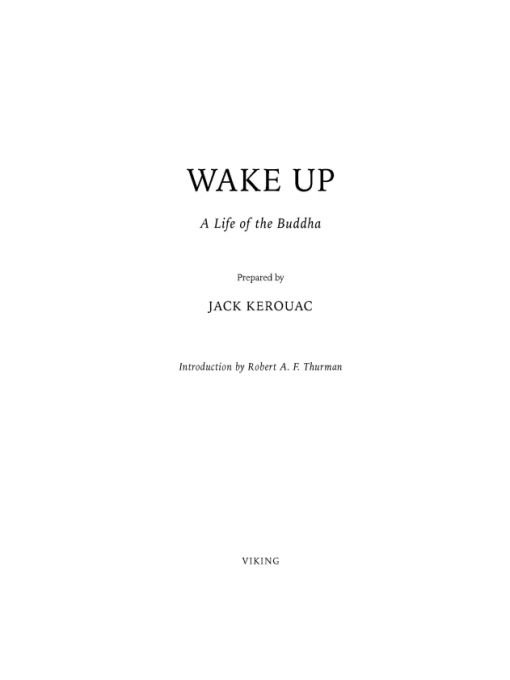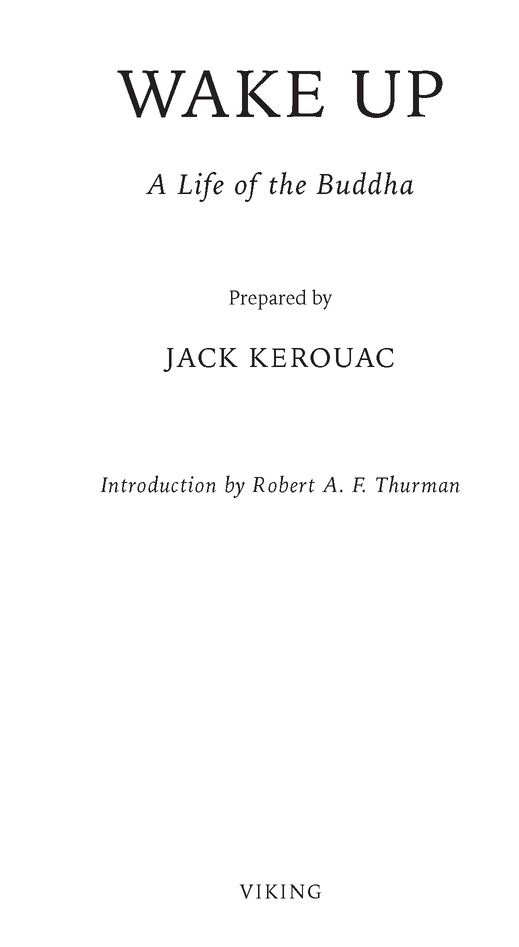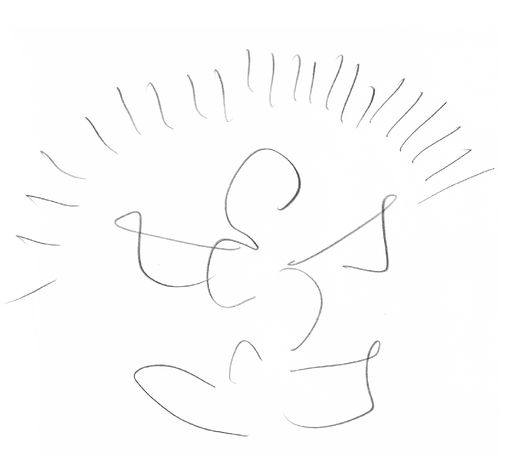Wake Up
Authors: Jack Kerouac


Table of Contents
ALSO BY JACK KEROUAC
THE DULUOZ LEGEND
Visions of Gerard
Doctor Sax
Maggie Cassidy
Vanity of Duluoz
On the Road
Visions of Cody
The Subterraneans
Tristessa
Lonesome Traveller
Desolation Angels
The Dharma Bums
Book of Dreams
Big Sur
Satori in Paris
Doctor Sax
Maggie Cassidy
Vanity of Duluoz
On the Road
Visions of Cody
The Subterraneans
Tristessa
Lonesome Traveller
Desolation Angels
The Dharma Bums
Book of Dreams
Big Sur
Satori in Paris
POETRY
Mexico City Blues
Scattered Poems
Pomes All Sizes
Heaven and Other Poems
Book of Blues
Book of Haikus
Book of Sketches
OTHER WORK
The Town and the City
The Scripture of the Golden
Eternity
Some of the Dharma
Old Angel Midnight
Good Blonde & Others
Pull My Daisy
Trip Trap
Pic
The Portable Jack Kerouac
Selected Letters: 1940-1956
Selected Letters: 1957-1969
Atop an Underwood
Door Wide Open
Orpheus Emerged
Departed Angels: The Lost
Paintings
Windblown World
Beat Generation: A Play
On the Road: The Original Scroll
Scattered Poems
Pomes All Sizes
Heaven and Other Poems
Book of Blues
Book of Haikus
Book of Sketches
The Scripture of the Golden
Eternity
Some of the Dharma
Old Angel Midnight
Good Blonde & Others
Pull My Daisy
Trip Trap
Pic
The Portable Jack Kerouac
Selected Letters: 1940-1956
Selected Letters: 1957-1969
Atop an Underwood
Door Wide Open
Orpheus Emerged
Departed Angels: The Lost
Paintings
Windblown World
Beat Generation: A Play
On the Road: The Original Scroll

Jack Kerouac, “Enlightenment,” pencil in sketchbook,
ca.
1956
ca.
1956
VIKING
Published by the Penguin Group
Penguin Group (USA) Inc., 375 Hudson Street, New York, New York 10014, U.S.A. • Penguin Group (Canada), 90 Eglinton Avenue East, Suite 700, Toronto, Ontario, Canada M4P 2Y3 (a division of Pearson Penguin Canada Inc.) • Penguin Books Ltd, 80 Strand, London WC2R 0RL, England • Penguin Ireland, 25 St Stephen’s Green, Dublin 2, Ireland (a division of Penguin Books Ltd) • Penguin Books Australia Ltd, 250 Camberwell Road, Camberwell, Victoria 3124, Australia (a division of Pearson Australia Group Pty Ltd) • Penguin Books India Pvt Ltd, 11 Community Centre, Panchsheel Park, New Delhi—110 017, India • Penguin Group (NZ), 67 Apollo Drive, Rosedale, North Shore 0632, New Zealand (a division of Pearson New Zealand Ltd) • Penguin Books (South Africa) (Pty) Ltd, 24 Sturdee Avenue, Rosebank, Johannesburg 2196, South Africa
Penguin Books Ltd, Registered Offices: 80 Strand, London WC2R 0RL, England
First published in 2008 by Viking Penguin, a member of Penguin Group (USA) Inc.
Introduction copyright © Robert Thurman, 2008
All rights reserved
All rights reserved
Frontispiece: “Enlightenment,” a drawing by Jack Kerouac. Henry W. and Albert A. Berg Collection of English and American Literature, The New York Public Library, Astor, Lenox and Tilden Foundations.
Selections from
A Buddhist Bible,
edited by Dwight Goddard. Copyright E. P. Dutton & Co., Inc., 1938. Used by permission of Dutton, a member of Penguin Group (USA) Inc.
A Buddhist Bible,
edited by Dwight Goddard. Copyright E. P. Dutton & Co., Inc., 1938. Used by permission of Dutton, a member of Penguin Group (USA) Inc.
eISBN : 978-1-440-66235-5
Without limiting the rights under copyright reserved above, no part of this publication may be reproduced, stored in or introduced into a retrieval system, or transmitted, in any form or by any means (electronic, mechanical, photocopying, recording, or otherwise), without the prior written permission of both the copyright owner and the above publisher of this book.
The scanning, uploading, and distribution of this book via the Internet or via any other means without the permission of the publisher is illegal and punishable by law. Please purchase only authorized electronic editions and do not participate in or encourage electronic piracy of copyrightable materials. Your support of the author’s rights is appreciated.
INTRODUCTION
What a surprise! Working on this introduction, it has become apparent to me that Jack Kerouac was the lead bodhisattva, way back there in the 1950s, among all of our very American predecessors. To introduce Kerouac introducing Shakyamuni Buddha, I’m just going to be personal since I’m not a scholar of the Beats and their literature. But Kerouac’s interpretation of “beat,” that it stands for “beatific” (which is how I like to translate the
sambhoga
of a buddha’s
sambhoga-kaya,
“beatific body”—his celestial, universal bliss-form) rather than for “beat up”—those who can’t take the industrial slave life, with its productions and its banks and its wars—this won my heart right away. Obviously it did way back when, I just couldn’t remember till now.
sambhoga
of a buddha’s
sambhoga-kaya,
“beatific body”—his celestial, universal bliss-form) rather than for “beat up”—those who can’t take the industrial slave life, with its productions and its banks and its wars—this won my heart right away. Obviously it did way back when, I just couldn’t remember till now.
I am grateful for the opportunity to write this introduction. It has been nearly fifty years since I read
The Dharma Bums
. Now that my love for the Buddhadharma—“the reality of the Enlightened One,” “the teaching of the Awakener” (to use not-at-all-bad Kerouac expressions for “Buddha”)—has become a bit of a public confession, I am sometimes asked how I came to my interest in it. I tend to mention what I have remembered up to now, that the ground was sown by my reading of Nietszche’s
Thus Spake Zarathustra,
Schopenhauer, Kant, Wittgenstein, Henry Miller, Herman Hesse, Freud, Jung, Wilhelm Reich, Lama Govinda, D. T. Suzuki, Evans-Wentz, and so on. I did not remember Kerouac. But I now realize that when I read
The Dharma Bums
as a teen in the late fifties, I was exposed to perhaps the most accurate, poetic, and expansive evocation of the heart of Buddhism that was available at that time. Not to say that it was perfect, or to pretend that I would be able to tell if it was or wasn’t—it’s just that it is so incredibly inspiring, and must have deeply affected my seventeen-year-old self in 1958, the year it was first published and the year I ran away from Phillips Exeter Academy and went looking for a revolution.
The Dharma Bums
. Now that my love for the Buddhadharma—“the reality of the Enlightened One,” “the teaching of the Awakener” (to use not-at-all-bad Kerouac expressions for “Buddha”)—has become a bit of a public confession, I am sometimes asked how I came to my interest in it. I tend to mention what I have remembered up to now, that the ground was sown by my reading of Nietszche’s
Thus Spake Zarathustra,
Schopenhauer, Kant, Wittgenstein, Henry Miller, Herman Hesse, Freud, Jung, Wilhelm Reich, Lama Govinda, D. T. Suzuki, Evans-Wentz, and so on. I did not remember Kerouac. But I now realize that when I read
The Dharma Bums
as a teen in the late fifties, I was exposed to perhaps the most accurate, poetic, and expansive evocation of the heart of Buddhism that was available at that time. Not to say that it was perfect, or to pretend that I would be able to tell if it was or wasn’t—it’s just that it is so incredibly inspiring, and must have deeply affected my seventeen-year-old self in 1958, the year it was first published and the year I ran away from Phillips Exeter Academy and went looking for a revolution.
Since 1958, perhaps since 1058, the multifaceted, lush, Indian sort of Buddhism Kerouac preferred has returned to the planet from Tibet, after having been lost outside of Central Asia for a thousand years. Indian Universal Vehicle, Mahayana Buddhism and its monastic university institutions—vibrant communities of monks led by scientific sages, some of them adept explorers of inner universes, who accumulated mountains of texts in vast, multistoried “Libraries of Alexandria”—were destroyed by Islamized Persian and Turkic invasions and occupations of the Indian subcontinent, and its Great Mother of Civilizations was further obscured by Christianized European waves of invasion, domination, and exploitation.
I don’t think I ever did read
On the Road
until just now for this assignment, and I don’t think I would have liked the shuffling con man aspect of Dean Moriarty that much, though my own hitch-hikings and frenetic New York to California wanderings beginning in 1958 and running intermittently into 1961 were somewhat similar. I never managed to hop a freight, though, and I admire Kerouac for his knowledge and guts in doing that.
On the Road
until just now for this assignment, and I don’t think I would have liked the shuffling con man aspect of Dean Moriarty that much, though my own hitch-hikings and frenetic New York to California wanderings beginning in 1958 and running intermittently into 1961 were somewhat similar. I never managed to hop a freight, though, and I admire Kerouac for his knowledge and guts in doing that.
A question has apparently been hanging over Kerouac as to whether he really understood much about the Dharma, as if he were not really genuine in his understanding of enlightenment, or some such entity. Alan Watts was heard to say that he might have had “some Zen flesh but no Zen bones,” referring to the title of a work by another writer on Zen, the redoubtable Paul Reps. And Gary Snyder, who spent years in Zen monasteries and is himself today a kind of Zen Roshi master as well as a poet, may have thought Kerouac didn’t quite get it, though he remained a loving friend. There is no doubt that his tragic addiction to alcohol, which cut his life and practice short at a tender forty-seven years of age, is evidence that whatever enlightenment he had attained was short of perfect buddhahood, as buddhas don’t usually drink themselves to premature death, since such doesn’t help anyone else and that’s all that buddhas do naturally. But who can really lay claim to that sort of transcendent physical and mental cosmic transmutation? In the vast psychological literature of the Buddhists, there are many analyses of the various stages of enlightenment; according to them it is quite possible to be enlightened to a certain degree and still prey to human failings. In fact, one becomes a
bodhisattva,
or hero for enlightenment, just by sincerely resolving and vowing to become perfectly enlightened in some future life, near or far, for the sake of developing the knowledge and ability to free all sensitive beings from suffering. That is, not all bodhisattvas are celestial or divine entities. Many are human, all too human.
bodhisattva,
or hero for enlightenment, just by sincerely resolving and vowing to become perfectly enlightened in some future life, near or far, for the sake of developing the knowledge and ability to free all sensitive beings from suffering. That is, not all bodhisattvas are celestial or divine entities. Many are human, all too human.
The thing about Kerouac that might have made him less accepted among early California Buddhists—Gary Snyder and Alan Watts and others—was that he was not so taken by the Ch’an/Zen line of things, though he loved the writings of Han Shan, the “cold mountain” poetic meditations transmitted by Snyder. Kerouac was more moved by the Indian Mahayana line, which emerges both in the work at hand, the sweet “lake of light” story of the Buddha’s life, and in his
Some of the Dharma
book notes composed for the benefit of his friend, dear Allen Ginsberg, which also gives us a record of Jack’s own study.
Some of the Dharma
book notes composed for the benefit of his friend, dear Allen Ginsberg, which also gives us a record of Jack’s own study.
Kerouac clearly loved the compassion stuff, what the Tibetans call the “magnificent deeds lineage” descended from Maitreya and Asanga. He loved dogs and they loved him. The Tibetans have a tradition, perhaps coming from the famous story of Asanga meeting Maitreya in the form of a dog, that the future Buddha Maitreya manifests generously in the form of dogs, ahead of his Buddha incarnation far in the future, in order to encourage depressed and frightened people to rise above their fears and develop trust and affection for another sentient being.
Significant is the note Kerouac gave Gary Snyder on the latter’s departure for Japan and further years of Zen practice, as recorded in the semifictional
Dharma Bums;
“MAY YOU USE THE DIAMOND CUTTER OF MERCY.” (Of course, as
Dharma Bums
is semifictional, you can’t tell if he really gave him such a note or just wished he did; but the point is the same.) The Diamond Cutter is one of the
Prajnaparamita Sutras,
Transcendent Wisdom highest Mahayana sutras, and mercy and compassion were the facets of the wisdom of enlightenment that most spoke to Kerouac’s Christo-Buddhist heart, which he didn’t want Gary to lose sight of with his macho samurai focus on Zen. I love Kerouac’s statement later in the novel, when he spends a summer in a fire-lookout cabin on Desolation Peak in Washington State’s Skagit Range: “Whenever I heard thunder in the mountains it was like the iron of my mother’s love.” He called the Buddha the “Jesus of Asia,” even “sweeter than Jesus,” and in
Wake Up
he relies extensively on Dwight Goddard’s anthology
A Buddhist Bible
(Goddard, being a Christian, tended to emphasize aspects of Buddhism that resembled his own faith). At the beginning of
Wake Up,
Kerouac quotes Goddard’s own dedication: “Adoration to Jesus Christ, the Messiah of the Christian World; Adoration to Gotama Sakyamuni, The Appearance-Body of the Buddha.—A BUDDHIST PRAYER in the Monastery of Santa Barbara, Written by Dwight Goddard.” Kerouac here openly approves of adoring both “saviors” equally.
Dharma Bums;
“MAY YOU USE THE DIAMOND CUTTER OF MERCY.” (Of course, as
Dharma Bums
is semifictional, you can’t tell if he really gave him such a note or just wished he did; but the point is the same.) The Diamond Cutter is one of the
Prajnaparamita Sutras,
Transcendent Wisdom highest Mahayana sutras, and mercy and compassion were the facets of the wisdom of enlightenment that most spoke to Kerouac’s Christo-Buddhist heart, which he didn’t want Gary to lose sight of with his macho samurai focus on Zen. I love Kerouac’s statement later in the novel, when he spends a summer in a fire-lookout cabin on Desolation Peak in Washington State’s Skagit Range: “Whenever I heard thunder in the mountains it was like the iron of my mother’s love.” He called the Buddha the “Jesus of Asia,” even “sweeter than Jesus,” and in
Wake Up
he relies extensively on Dwight Goddard’s anthology
A Buddhist Bible
(Goddard, being a Christian, tended to emphasize aspects of Buddhism that resembled his own faith). At the beginning of
Wake Up,
Kerouac quotes Goddard’s own dedication: “Adoration to Jesus Christ, the Messiah of the Christian World; Adoration to Gotama Sakyamuni, The Appearance-Body of the Buddha.—A BUDDHIST PRAYER in the Monastery of Santa Barbara, Written by Dwight Goddard.” Kerouac here openly approves of adoring both “saviors” equally.
Other books
Steel: (#5 The Beat and the Pulse) by Amity Cross
Dead Rules by Randy Russell
The Silver Chalice by Thomas B. Costain
The Cain File by Max Tomlinson
For Real (Rules of Love, Book One) by Cameron, Chelsea M.
The Lost Souls Dating Agency by Suneeti Rekhari
A Lost Kitten by Kong, Jessica
4 Maui Macadamia Madness by Cynthia Hickey
Yearning by Belle, Kate